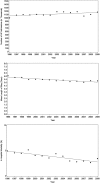Trends in hospitalization for congestive heart failure, 1996-2009
- PMID: 27862089
- PMCID: PMC6490534
- DOI: 10.1002/clc.22638
Trends in hospitalization for congestive heart failure, 1996-2009
Abstract
Background: Although heart failure (HF) is a common cause of hospital admissions, few data describe temporal trends in HF hospitalization. We present data on number of HF admissions, length of stay (LOS), and inpatient mortality in the United States, 1996-2009.
Hypothesis: To assess HF hospitalizations in a national sample of United States population.
Methods: Data were obtained from the National Hospital Discharge Survey (NHDS), a national probability sample survey of discharges conducted annually by the National Center for Health Statistics. Sampling weights are applied to raw NHDS data to produce national estimates. Hospitalizations with a primary diagnosis of HF were identified using ICD-9-CM codes. We excluded hospitalizations where HF was a secondary diagnosis. Weighted least squares regression was used to test for linear trends in HF hospitalizations.
Results: Approximately 15.5 million weighted primary HF hospitalizations were included. The number of total primary HF hospitalizations increased from 1 000 766 in 1996 to about 1 173 832 in 2009 (β = 7371 hospitalizations per year; 95% confidence interval (CI): 552 to 14 190, P = 0.036). Mean LOS per hospitalization decreased from 6.07 days in 1996 to about 5.26 days in 2009 (β = -0.059 days per year; 95% CI: -0.079 to -0.039, P < 0.001). Inpatient mortality rates declined from 4.92% in 1996 to 3.41% in 2009 (β = -0.17% per year; 95% CI: -0.23 to -0.10, P < 0.001).
Conclusions: In a nationally representative sample of HF hospitalizations, mean LOS and inpatient mortality rates declined over the past 2 decades. HF management cost is most likely to be reduced by decreasing the number of HF admissions.
Keywords: Admissions; Heart failure/cardiac transplantation/cardiomyopathy/myocarditis; Mortality.
© 2016 Wiley Periodicals, Inc.
Conflict of interest statement
The authors declare no potential conflicts of interest.
Figures




References
-
- Tunstall‐Pedoe H, Kuulasmaa K, Mähönen M, et al. Contribution of trends in survival and coronary‐event rates to changes in coronary heart disease mortality: 10‐year results from 37 WHO MONICA project populations. Monitoring trends and determinants in cardiovascular disease. Lancet. 1999;353:1547–1557. - PubMed
-
- Spencer FA, Meyer TE, Goldberg RJ, et al. Twenty‐year trends (1975–1995) in the incidence, in‐hospital and long‐term death rates associated with heart failure complicating acute myocardial infarction: a community‐wide perspective. J Am Coll Cardiol. 1999;34:1378–1387. - PubMed
-
- Ghali JK, Cooper R, Ford E. Trends in hospitalization rates for heart failure in the United States, 1973–1986: evidence for increasing population prevalence. Arch Intern Med. 1990;150:769–773. - PubMed
-
- Mozaffarian D, Benjamin EJ, Go AS, et al. Heart Disease and Stroke Statistics—2016 update: a report from the American Heart Association. Circulation. 2016;133:e38–e360. - PubMed
Publication types
MeSH terms
LinkOut - more resources
Full Text Sources
Other Literature Sources
Medical
Research Materials
Miscellaneous

